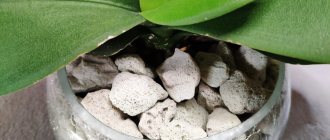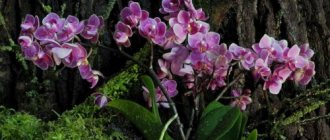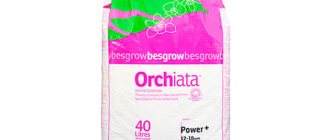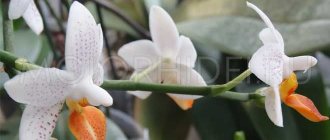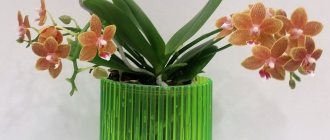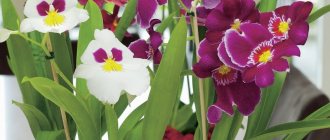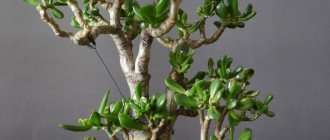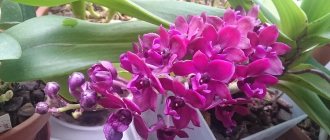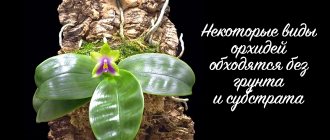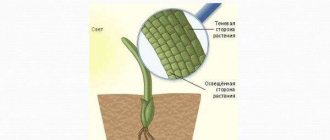This a wonderful new product to grow tropical beauties. This substrate can save the life of even the smallest sprout.
Therefore, it is indispensable for the resuscitation of orchids , and they will delight you with good growth and excellent flowering in due time.
What it is?
Attention : Seramis is a ready-made balanced complex intended for caring for indoor plants. The product is clay granules enriched with several types of fertilizers.
Components for Seramis are supplied by Germany . Recently, this substrate has become popular in Russia. In Western Europe, it is actively used when planting potted plants.
Small clay granules are porous and lightweight. They actively absorb excess moisture. The soil does not lose its properties regardless of operating conditions and period.
Unlike other soil mixtures, Seramis provides good air exchange in the pot . With such a substrate, orchids feel comfortable and enjoy healthy growth and abundant flowering.
If after replanting the soil is not completely used, it must be properly stored in a dry, dark place.
We recommend watching a video about Seramis for orchids:
German clay soil Seramis
A modern analogue of earth for healthy plants and beautiful spaces
Seramis (emphasis on I) is a natural clay soil for indoor and garden plants. It works as a natural automatic watering system, is suitable for any plants, can be reused and has no expiration date, provides comfortable gardening without earthy stains, odor and insects.
- There is a universal Seramis for orchids and succulents.
All components of the Seramis complex are produced in Germany from German, Italian and Portuguese raw materials. The soil entered the market almost 30 years ago and very quickly gained popularity in Europe. Private homes, hotels, restaurants, cafes, salons, boutiques, administrative interiors, sports complexes, offices, city lawns and garden beds - Seramis is used everywhere. In the Russian market, soil is just gaining popularity. But those phytodesigners, flower growers and decorators who have tried Seramis always return for new packaging.
Compound
The Seramis complex is a substitute for natural soil for orchids . The substrate is made from baked clay and tree bark. Contains beneficial microelements NPK:
- Phosphorus.
- Potassium.
- Nitrogen.
Clay granulate particles absorb watering moisture like a sponge and distribute it throughout the pot. Thanks to the safe accumulation of liquid, plants are protected from root rot.
Substrate granules of different sizes . This makes it possible to save the life of even a small shoot with undeveloped roots.
Indications and contraindications
So, let’s summarize – for which plants Seramis is good, for which it is acceptable and for which it is unsuitable. Plants that love dense, heavy, nutritious soil will definitely not survive in Seramis. These are natives of tropical forests, humid subtropics, swamp plants - amphibians and semi-amphibians - and spring-autumn semi-ephemera: monstera, ficus, begonias, tradescantia, hibiscus, bamboo, cyperus (papyrus), oleander, balsam, pelargoniums (geraniums), primroses, cyclamen. Of the Gesneriaceae (which also includes the Uzambara violet), gloxinia and tidea do not take root in Seramis.
Succulents and ephemerals of tropical deserts and semi-deserts literally thrive in Seramis: cacti, aloe, euphorbia, crassula, aizoonaceae (stone plants), amaryllis. Good bonsai can be grown on Seramis with minimal experience in this matter. Palm trees, dracaena, citrus fruits, etc., which love loose, moist, nutritious soil, can be planted in Seramis if it is impossible to provide them with stable, sufficient moisture, for example, when keeping them in an office that is empty on weekends, and on holidays for up to a week or more.
As for orchids, planting in Seramis makes caring for them much easier for a novice hobbyist. But in the future, as experience is gained, it will be better to switch to natural or artificial substrates, the properties of which are as close as possible to those natural for a given species. There are many substrates for orchids on sale, see video review:
Advantages and disadvantages
Like any ready-made soil mixture, Seramis can have both advantages and disadvantages. Positive qualities of the substrate:
- Maintaining its original structure regardless of time.
- Easy to use when transplanting plants.
- There is no need to replace the soil several times a season.
- Avoiding pot leakage. The substrate can be poured into containers without drainage holes.
- Possibility of reuse in case of death of the plant in the pot. The mixture is washed and “baked” in the oven for half an hour.
- Reducing the risk of fungi and mold.
Seramis can be used for many years in unlimited quantities. Plants are transplanted into prepared soil without clearing the roots from the soil, and they quickly get used to the new place. There were no deficiencies found in this soil mixture.
Seramis is a universal granule for orchids that feed on air (epiphytic plants) . This soil is suitable for planting both Vanda and Phalaenopsis.
Seramis and fertilizers
Seramis substrate is not a nutrient medium, even an orchid one. Plants planted in Seramis need to be fertilized with a complete complex fertilizer, similar to hydroponics. If they are planted in general-purpose Seramis, they can be fed with any suitable fertilizer. But if Seramis is used for orchids, at first it is necessary to use only fertilizers from the Seramis system. Switching, if necessary, to other fertilizers is not easy and quite risky: you need to stop feeding until the plant shows signs of starvation, and only then start giving “non-native” fertilizers. Fertilizing begins in the same way if the plants are planted in orchid Seramis, and it is undesirable to use “branded” fertilizers for it for some reason.
Features of planting in soil mixture
Replanting an orchid is a responsible task for both beginners and experienced gardeners. In order for the plant to take root and delight with lush flowering, it is important to strictly follow the transplantation rules.
The orchid is transferred to the substrate only after it has bloomed . The peduncle is cut to restore vitality after replanting.
Before performing the work, prepare the following equipment:
- Manicure scissors or garden pruning shears.
- A new orchid pot, larger in size than the previous one.
- Seramis series primer.
- An activated carbon tablet or bactericidal preparations for treating cut sites. This will save the orchid from death.
Plastic, ceramic pots, glass and even metal containers are suitable for filling with Seramis . Metal containers are lined with foil inside to avoid oxidative processes.
And we will talk in more detail about pots for orchids, for example, the Corona type, transparent ones, flowerpots, glass vases, flasks and others, as well as about planting in a block, in other articles.
The flower is removed from the old container with great care so as not to harm the fragile root system. To facilitate this task, the orchid is not watered before planting. It is not necessary to clear the roots from the previous soil. Further actions are carried out sequentially:
- The root system of the flower is examined to identify lesions. If a pest is detected, the plant is immersed in filtered warm water. For the final destruction of parasites, special preparations are used.
- The roots are diagnosed. Rotten and dried ones are cut with scissors or pruning shears. The cut areas are treated with bactericidal compounds or activated carbon.
- Remove yellow and lifeless leaves and soft hollow bulbs. The cut sites are disinfected.
- The orchid roots are dried for eight hours.
- Prepare a container for the plant - disinfect it, lay a drainage layer.
- After 8 hours, the flower is carefully placed in the middle of the pot, filling the voids with Seramis soil mixture. The ratio of soil and rhizomes of the planted orchid should be 2:1. Aerial roots do not fall asleep.
The substrate is placed in a container with a flower so that it does not dangle . The soil is not compacted.
We recommend watching a video about transplanting an orchid into Seramis:
Seramis soil for orchids
A long-awaited new product - a special Seramis primer for orchids
- immediately after its appearance, it proved itself perfectly and quickly became popular among amateurs and professional orchid breeders.
Seramis soil consists of 70% special large clay granules and 30% pine bark from Portuguese forests. Plant roots are in their natural woody environment and have access to air due to the large size of the bark and granules. Plus they get enough moisture. Seramis soil is essentially a natural automatic watering system. A porous clay granule absorbs an amount of water and fertilizer equal to its own weight. And then gradually gives it to the plant.
Large granules and pieces of bark create an airy structure, providing optimal ventilation to the sensitive orchid roots and ideal water balance. You can forget about the two worst nightmares of orchid lovers: waterlogging and root rot.
Seramis soil makes replanting orchids non-traumatic for the plant and easy for you. We recommend replanting before or after the flowering stage.
Growing a flower in a substrate
Orchids planted in the substrate must be provided with proper care so that they recover faster. After replanting, the pot with the plant is left in the same place or moved to the eastern window. Basic rules for flower care in Seramis:
The first watering after transplantation should be carried out after 4-5 days. To moisturize, use clean warm water.- Protect the orchid from direct sunlight.
- Maintain the temperature in the range from plus 20 to 22 degrees.
Watering orchids growing in Seramis is done no more than once every 20 days . For better orientation in the orchid pot, install a humidity indicator. Blue indicates good fluid balance. Red signals the need for watering.
Tip : In order for the flower to quickly take root in a new place, a complex fertilizer of the same series is added to the irrigation water.
Thus, Seramis is a good complex substrate, suitable for breeding all representatives of the orchid family . It only has a positive effect on the development of orchids.
Storage
Regular and succulent Seramis can be stored without special precautions, as long as it does not absorb moisture from the air, for example, in an original bag that is torn and sealed with tape. But Seramis for orchids cannot be stored in opened containers. If less than 2.5 liters of it is required (usual packaging capacity), then, having selected a part, the container must also be sealed with tape, placed in a thick plastic bag, sealed as well, and stored in a dark room (or storage) at a temperature no higher than + 22 degrees. Just in case - under constipation from children and animals, because... The granules are already just clay, but impregnated with agrochemicals.
"Ambulance"
Like many nutrient substrates, it has mixed reviews and recommendations. Is this due to poor quality of the manufacturer or counterfeits? But, if you manage to purchase a high-quality batch, the grower will not be disappointed. The popularity of "Emergency" is above average.
The nutrient substrate is suitable for all types of orchids. Created based on:
- High peat;
- Plus tree bark (pine).
The advantages, according to the manufacturer, include:
- Provides a good microclimate inside the flower container;
- It has a good effect on the survival rate of the plant after transplantation;
- Provides resistance to diseases, stress and improves immunity;
- Helps improve decorativeness;
- Removes the harmful effects of fertilizers and other soil substrates;
- It has a good effect on the development of beneficial microflora and also helps eliminate harmful ones.
The manufacturer guarantees:
- Cleanliness;
- Naturalness;
- And the safety of the composition.
Contains a complete set of micro and macroelements necessary for the full development and growth of orchids.
Advice! It is better to use it as a component when making your own substrate.
Recommendations
There are some other nuances when using Seramis. Experienced gardeners give several additional recommendations for using soil.
- Although eggs, larvae and mold do not survive in this composition, this problem cannot always be avoided when using rainwater. Rainwater contains microdust, which gradually accumulates between soil granules, and in these spaces pathogenic microorganisms feel quite comfortable. Therefore, do not use rainwater when watering orchids.
- Seramis should not be considered a nutritional composition. When using it, plants also need to be fed regularly. Any complexes are suitable for flowers grown in General Purpose Ceramis. If “Ceramis for orchids” is used, then it is necessary to fertilize the flowers only with fertilizers from the Seramis line. When transferring a crop to a new fertilizer, you must wait until it is completely starved, and only then start using the new composition.
- The next tip concerns the storage of Seramis. All its varieties do not require special conditions for this and can be stored in torn and sealed packaging, preventing the ingress of moisture and air. However, Seramis for Orchids cannot be stored in an opened bag. It is best to completely use the purchased mixture at one time. But if this is not necessary, then the container is also sealed with tape, put into a sealed plastic bag, sealed with tape again and stored in a dark room at a maximum temperature of +22 degrees.
The vast majority of reviews about Seramis are positive. Flower growers note that after trying the soil on other indoor plants, they did not hesitate to switch the orchids to the same composition. Thanks to Seramis, some managed to save a dying specimen. Phalaenopsis are mainly grown using this mixture, but users share the secrets of transplanting ondicium, miltonia, and dendrobium into the soil. The disadvantage is the high price of the product.
For information about what “Ceramis” and “Ceoflora” are for orchids, see the video below.
What flowers is it suitable for growing?
The Seramis complex is suitable for all types of orchids. This is achieved by the balanced composition, breathability and moisture-absorbing properties of the soil.
Two types of granules have been developed for growing orchids: general purpose and “Ceramis for orchids”:
- The second option is considered universal and contains a combination of microelements that help stimulate flowering.
- “General purpose ceramis” is also used for keeping orchids, but is suitable for different varieties, depending on the size of the granules.
- Coarse-grained "Orchidan" - for adult, picky plants.
- Medium granular - for phalaenopsis.
- Fine granular - for low varieties of orchids. Least suitable for growing them.
Reference! Fine granular substrate is excellent for rooting shoots.
What does the substrate for orchids consist of?
The substrate for orchids can consist of different fillers, I will talk about them in more detail below. But when choosing a preparation in a store or assembling it yourself, it is worth remembering the main tasks that the mixture should solve:
- Good at absorbing moisture. This is necessary for the uniform release of water to the plant and the removal of excess liquid.
- Dry quickly to prevent roots from rotting.
- Allow enough air to keep conditions close to natural.
- Saturate the environment with nutrients.
Stores often sell ready-made bark-based mixtures for orchids. They meet basic requirements and are used successfully by many breeders. The main risk is that the substrate may cake and deteriorate during storage. Also, the industrial harvesting method is not capable of ensuring a sufficiently thorough selection of bark, so the set will contain pieces of different quality.
Orchid bark
The main substrate filler for orchids is bark. Pine is most often used - it is light, absorbs moisture well, dries quickly and is widely available. It's easy to find and prepare. However, you can also find mixtures based on other types: spruce, larch, oak bark. The main thing here is the correct collection and processing of the material.
So what kind of bark do you need? If we talk about conifers, then it is best to collect bark from already dead, dried trees, so it will contain less resin. It is imperative to choose areas that are not damaged by the sun, rot, or pests. For adult orchids, the particle size needed is approximately one centimeter long and wide.
Important components - moss and coal
However, bark for orchids, although the main one, is not the only filler needed. If you are using ready-made substrates, make sure they contain other elements as well. If necessary, add them separately. The most basic components are considered to be the following:
- Sphagnum moss,
- Charcoal.
Sphagnum is the most common moss in Russia. For growing orchids it is used both live and dry. Thanks to its structure, it provides sufficient ventilation of the roots. It is also capable of absorbing large amounts of moisture, performing two functions at once: it retains water and evenly releases it to the plant, and also protects aerial roots from rotting.
In addition, mosses contain a large amount of nutrients needed by orchids. In addition to sphagnum, you can use other types, for example, cuckoo flax. The main thing to remember is that dry mosses decompose quickly, and therefore they need to be changed at least 2 times a year.
Charcoal - most often birch - is used as an absorbent: it absorbs harmful substances, such as excess salts. Small pieces of the same size as orchid bark are added to the pot - 1-2 cm in diameter. It is advisable to replace the coal periodically.
Other components
In addition to the main components of the substrate: pine bark, moss and charcoal, other components are sometimes added. The following additives are common in Russia:
- High peat. It is highly breathable and can absorb large amounts of moisture. However, in the future you will have to deal with excessive soil acidity and also look for additional sources of nutrients. This supplement is good for mature and strong plants.
- Cones, nut shells, and dry fern roots serve simultaneously as a leavening agent, mulch for better ventilation of the roots, and a source of useful micro- and macroelements. Exotic coconut fibers are also suitable.
- Fallen leaves, rice husks. As these components decompose, they will provide the orchid with additional nutrition.
Inorganic components
You can also add inorganic components to the mixture of orchid bark, such that they will be chemically inert, while making the substrate more loose. Some materials also retain moisture well. Most often added:
- Coarse sand - it makes the soil lighter.
- Expanded clay, perlite and vermiculite are used as additional drainage.
- Polystyrene foam and foam rubber are also great for loosening and retaining moisture.
general description
Seramis is a granular primer made in Germany.
A ready-to-use balanced soil mixture acts as a substitute for a natural substrate and is designed specifically for home growing of indoor flowers, including well suited for orchids.
The composition is based on processed clay and pine bark, and also includes mineral additives that act as fertilizer (nitrogen, potassium and phosphorus).
Available for free sale in pure form or with dietary supplements in packaged form of various volumes. Granules are produced in 3 sizes. They have increased porosity.
Beneficial features
The main components - clay and pine bark - have good moisture absorption, gradually releasing water to the roots of the plants, which is a key point in caring for orchids. Flowers receive moisture from porous granules.
The use of this type of substrate creates a balanced air-water microclimate in the pot, protecting the root system from rotting.
The structure of the soil, consisting of granules of different diameters, allows not only massive, but even small and weak roots to take root firmly, which is important when resuscitating ruined indoor plants.
Mineral additives in the soil substitute ensure full growth of green mass, activate flowering and prolong the duration of budding.
The soil mixture is indispensable for restoring orchids weakened by improper care during cultivation and helps maintain the health of fragile shoots.
During application, there is no need to place pots on pallets, and the structure of the granules maintains the surrounding cleanliness.
For which varieties is it suitable?
The granular nutritional composition is suitable for all types of orchids, but is most often used for phalaenopsis, dendrobium, miltonia, cattleya, vanda, which are most susceptible to root care and often suffer from waterlogging of the soil.
What to rely on when choosing?
When choosing ready-made soil for orchids, you need to understand exactly what composition is needed specifically for your plant. If you have unpretentious Phalaenopsis, Dendrobium, the product that contains the following will be suitable:
- bark;
- charcoal;
- sphagnum moss.
Wanda, Miltonia, Dracula need other components.
Some gardeners prefer one-component substrates to create their own soil based on them. In this regard, “Effect Bio” with pieces of bark of various sizes is convenient.
Universal soil is not suitable for fastidious, demanding varieties of epiphytes, and Phalaenopsis feels good even without a premium mixture.
Top best soils
The most affordable soils can be considered (from 59 rubles per 1 liter):
- Geolia;
- "Black Gold";
- "Flower Happiness";
- "Fasco";
- "Ambulance".
“Living World” also has an affordable price, but is not found in all cities of Russia. The same can be said about the Black Gold soil. In terms of composition, Seramis is most praised (from 571 rubles for 5 liters), although its mixture contains a lot of fine fractions. Kekkila “Ceoflora” and Geolia have proven themselves well on the flower growers’ forums.
The most negative reviews are found among users of the “Ambulance” soil, where both mealybugs and fungus gnats were found in some of the packs.
